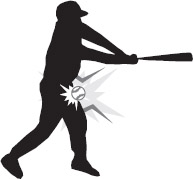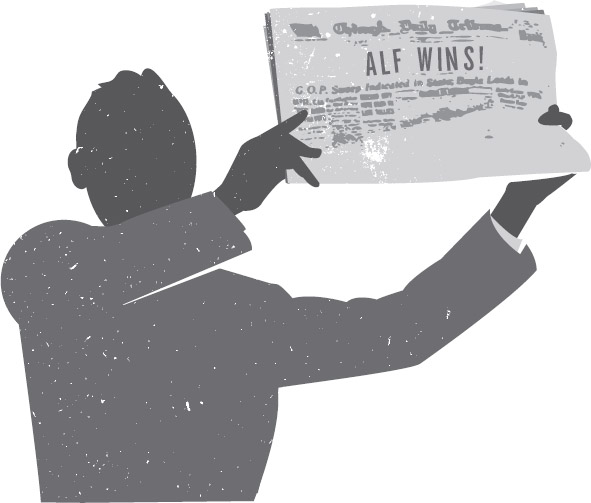Uncle John’s Bathroom Reader Zipper Accidents (16 page)
Read Uncle John’s Bathroom Reader Zipper Accidents Online
Authors: Uncle John’s



HANKS A LOT
The 1924 World Series went about as far as it could go: a decisive game seven and into 12 innings. The score was tied at three when the Washington Senators’ Muddy Ruel hit an easily catchable pop-up fly into foul territory behind home plate. It should have been an easy out for
New York Giants catcher Hank Gowdy, but somehow, someway, Gowdy got his foot caught in his catcher’s mask. Instead of snagging the ball, he tripped over and fell down. Ruel, still at bat, then hit a double, and then scored the run that enabled Washington to win the World Series.
OFF THE DOME
On May 26, 1993, the Cleveland Indians were playing the Texas Rangers when Indian Carlos Martínez hit a long fly ball to right field. The Rangers’ José Canseco ran back after it, looked as if he was about to catch it, lost sight of it…and then the ball hit him right on top of the head and bounced over the wall. Home run.
ITCHING TO PITCH
Three days after Canseco’s gaffe, the Rangers were down 12–0 to Cleveland in the eighth inning. Since the game seemed unwinnable, Canseco asked his manager, Kevin Kennedy, if he could pitch—something he hadn’t done since high school. Kennedy let Canseco take the mound. Not only did Canseco pitch badly—he surrendered three walks, allowed two hits, and three runs—he also injured his arm. Canseco had only a few at-bats in the next several games, and six weeks later finally had to have reconstructive surgery—and was out for the rest of the 1993 season.
LESS THAN PERFECT
On June 2, 2010, Detroit Tigers pitcher Armando Galarraga was about to complete a perfect game—pitching all nine innings and allowing no hits, walks, or runs. At the time, it had only been accomplished 20 times in Major League Baseball history. Galarraga had one ball and two strikes on the Cleveland Indians’ Jason Donald. Galarraga threw, and Donald hit a soft grounder between first and second base. First baseman Miguel Cabrera ran to his right to get it as Galarraga streaked toward first. Cabrera snagged the grounder and tossed it to Galarraga, who caught it and tagged first at virtually the same time Donald got there. Umpire Jim Joyce called Donald safe. The crowd, the announcers, the players—most especially Galarraga—were stunned into silence. Donald, who had just been called safe, cringed and put his hands on his helmet—because even he knew he was out, and that Galarraga had been robbed of a perfect game. Footage of the incident—which was replayed thousands of times on sports shows all over the country in the following days—showed clearly that Donald was out. Galarraga got the next batter out, and the game ended—just another game. Umpire Joyce, a 23-year veteran and considered one of the best umps in the game, met with Galarraga and the press after the game and admitted that he’d gotten the call wrong. “I just cost the kid a perfect game,” he said, tearfully apologizing to the Tigers pitcher. Galarraga quipped to reporters, “Nobody’s perfect.”
A
T&T used to invite customers to “reach out and touch someone,” but for much of January 15, 1990, the only thing AT&T users could reach out to was a dial tone. At the time, AT&T handled 115 million calls a day, routing them through a nationwide network of switching stations. Around 2:00 p.m,. a station in New York went offline for a routine four-second diagnostic. Back online, an engineer informed the other stations it would start delivering calls again, which it did, 10 milliseconds later.
The close timing of the two messages confused a second switching station, causing it to reset. During the reset, a backup switch received two more closely timed messages, which caused it to reroute its calls. Which caused a
third
switching station to go offline, which shut down a fourth, and so on, until all 114 switching stations were down in less than three seconds.
At first AT&T thought they’d been hacked. The real problem: The switches had done exactly what they were programmed to do. When the company updated the computer system a year earlier, a programmer flubbed a line of code that would have kept the switches from resetting. It took AT&T nine hours to get the network back online. Between 50 and 70 million calls had been were lost.
F
loored.
In 1870 the James Robinson & Co. Circus and Animal Show wanted to drum up some publicity for its touring cavalcade prior to a performance in Middletown, Missouri. As the clowns, circus performers, and animals paraded through town, the circus band was ordered to play while standing on the roof of a cage that held two lions. Despite concerns that the roof wasn’t strong enough, circus managers forced the band to play on, and they did, up until the moment the roof caved in, plunging the musicians into the den of hungry lions, who tore them limb from limb and ate most of their bodies. Ten band members started the parade; only three survived the mauling.


No Tell-ing.
Annie von Behren starred in an 1882 production of the play
Si Slocum
. One scene called for the actor playing opposite her, her real-life fiancé, Frank Frayne, to shoot an apple off of her head with a rifle—with his back to her. More than 2,300 people watched one night as Frayne pulled the trigger, releasing a bullet that missed the apple entirely in favor of von Behren’s forehead.
T
he Literary Digest
was among America’s most popular and credible news and opinion magazines in the 1920s and ‘30s. More than a million Americans got their news, news analysis, and editorial opinions from
TLD
by 1927.
One of the magazine’s most popular features was an exhaustive presidential straw poll in which it asked around 10 million Americans who they planned to vote for. It accurately predicted the winner of every presidential election from 1920 to 1932.
TLD
conducted the poll once more in 1936, declaring that the Republican challenger, Kansas governor Alf Landon, would defeat incumbent Democratic president Franklin Roosevelt, 57 to 42 percent, and with 370 electoral votes, a massive landslide for Landon.
Actual result of the 1936 presidential election: Roosevelt beat Landon 60.8 percent to 36.5 percent, and carried 46 of 48 states for an electoral college total of 523–8, the biggest landslide in history to that point.
How did
TLD
get it so very wrong? The people they polled did not represent a cross-section of the American electorate. In 1936 America was deep into the Great Depression. People struggled to feed and clothe themselves, and one of the
casualties was magazines. Only the wealthy could afford a subscription to a magazine such as
The Literary Digest. TLD
included its own readers in its poll, but the bulk of survey respondents came from two other groups: owners of cars and telephones, both of which were exorbitantly expensive and also available only to the wealthy, and heavily Landon-favoring, voters of 1936.
The poll cast so much doubt on
The Literary Digest
’s credibility that it directly led to the magazine’s end. Less than two years later, it was bought out by a competitor,
Review of Reviews
. That magazine went out of print less than a year later.


MARINER
N
ASA’s first mission to study the inner solar system was the Mariner Program, 10 unmanned space probes that visited Mercury, Venus, and Mars.
Mariner 1
, launched on July 22, 1962, was supposed to be a three-and-a-half-month flyby of Venus to gather information about its atmosphere.
